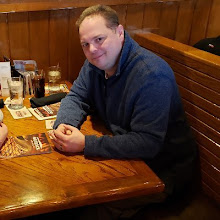Brad’s April Escape - Episode 2
April 2 - Close Encounters of the Third Kind (1977
Each weekday this month, I’ll screen a film from The Bearded Trio Cinematic Universe and list 10 random scenes, characters, musical cues or performances that I particularly enjoy and look forward to upon every viewing. I’d love to hear similar little things you enjoy about these films, and hope you join me in this escape from the present-day world.Starting this month-long series is that “other” movie that came out in 1977, Close Encounters of the Third Kind.
I’ll be up front about this film...today was the first time I ever sat down and watched it from start to finish. I selected the Director’s Cut on my blu-ray copy. I felt compelled to purchase this movie several years ago, because I considered it Essential Spielberg/Williams. And I caught slices of the film here and there over the years, mainly the model train scene at the beginning, and the Devil’s Tower sequence at the end.
So some of these observations will lack the clarity and sophistication of the other films I know much more intimately. But I watched this through the lens of Spielberg’s career. What elements were present here that I have noticed about him over the years? I am far from a film expert or critic. I can’t claim to expertly analyze shots, framing or composition. I took this in as a fan and hope some of these impressions can be fresh and insightful for an audience that is far more well-versed in this film than I am.
10 Things I Like - Close Encounters of the Third Kind (1977)
I would guess most people came into this movie having an idea of what to expect. Quiet. Dark. Inherently spooky. I relate this opening to that of Jurassic Park, in that it immediately set the proper tone for the film to come.
Watching this now, you see so many common elements present in his future films. An open refrigerator with spilled food and drink. A quiet blond kid. Unexplained electronic disturbances. Single mom with blonde hair. A road overlooking a suburb in the valley. Is it a coincidence that so many of these little details come up, in only slightly different form, in future Spielberg films?
A passage here for Richard Dreyfuss. By the time he was 30, he had starred in American Graffiti, Jaws, Close Encounters of the Third Kind, and none of those three films netted him the Oscar he won for 1977’s The Goodbye Girl. But to have played prominent roles in three films like that, so close together and at such a young age, is remarkable. I only wish he could have avoided the problems that plagued him in the early part of the 1980s. His career had a very nice renaissance in the 1990s, but I can’t help to wonder where he could have gone with a clean bill of health following his three mega-hit performances.
One more bit about Dreyfuss...can you imagine aging like his characters did from AG to Jaws to CET3K?? Man, the 70s were rough on everyone.
The sequence with Jillian and Barry in the house has serious Poltergeist vibes.
“There’s always some joker who thinks he’s immune.” - yeah that line hits a little close to home right now.
As a homeowner, the scene where all the dirt gets thrown into the kitchen makes me cringe. Can you imagine anyone wife’s standing by and watching one yard item after another get thrown into the sink? No wonder Ronnie left and was never to be seen again!
At different parts of the film, you see a billowing clouds effect. It gives me some real Flash Gordon vibes. I wonder if the same effects were used for those sky sequences in the two films. The effects today, of course, look dated and obvious. But back then, one’s suspension of disbelief was a bit greater, and it was one of those elements of the fantastic you accepted as part of films like this.
The absence of sound as the mothership slowly flies over the Devil’s Tower installation is a perfect choice. The ship commands the attention of all of your senses, as it should. This has been the MacGuffin of the film, and the pace of this film demands that it stands alone, for the eyes and the ears, as it makes its sweeping entrance.
I knew of the John Williams musical cue that defines the final sequence of the film. But I was delighted to hear it played here and there throughout the film, especially by Barry. This being the second collaboration between Williams and Spielberg, I’d love to hear the conceptual conversations between the two in the pre-production phase of the film, which is when that cue had to be recorded. Hearing that music was the most fun part of this film experience for me.
In some ways, this is a quintessential Spielberg film in that the first, easy perception is that this film is about aliens. When in fact, it’s about something completely different, that being a man grappling with an obsession that costs him nearly everything, but in the end, he finds what he didn’t know he was looking for. To me, that captures the same thematic direction of E.T. (not about the alien, but a boy dealing with divorce), Saving Private Ryan (not about the character James Ryan, but more about Captain Miller) and Jurassic Park (it’s not about dinosaurs, but about the power of nature). I’m sure there are dozens more examples of this. I can’t think of any other storyteller that is able to balance these elements in a similar way.
Coming tomorrow - Star Wars: A New Hope (1977)













Comments
Post a Comment
I would love to hear your thoughts. Please leave a comment, don't be shy.